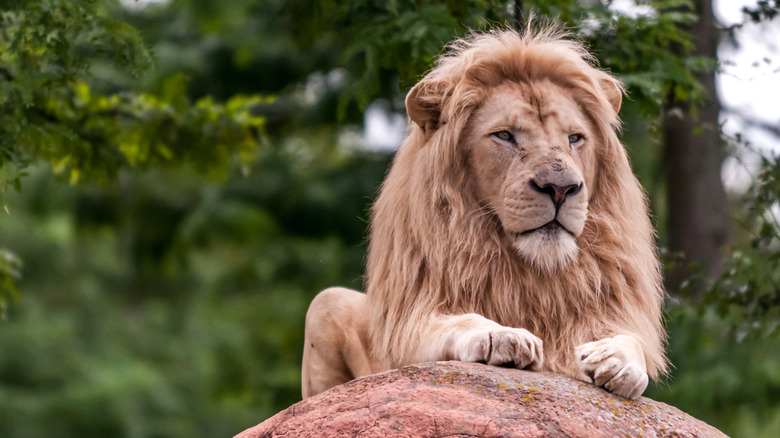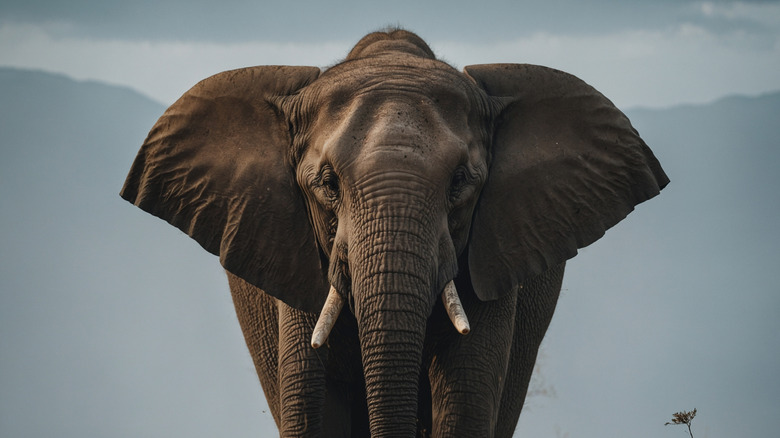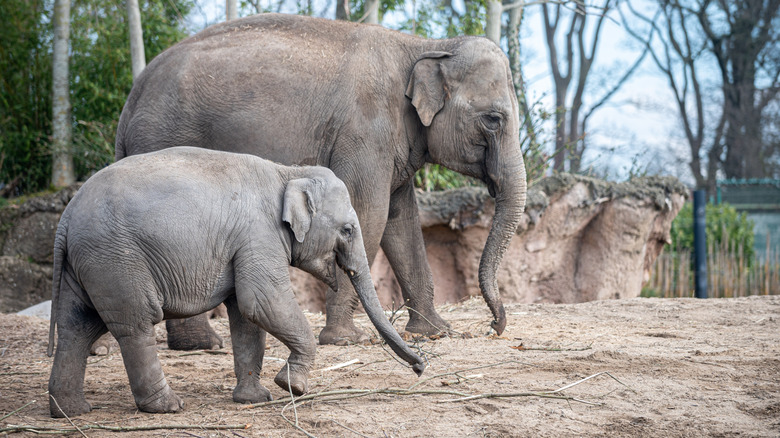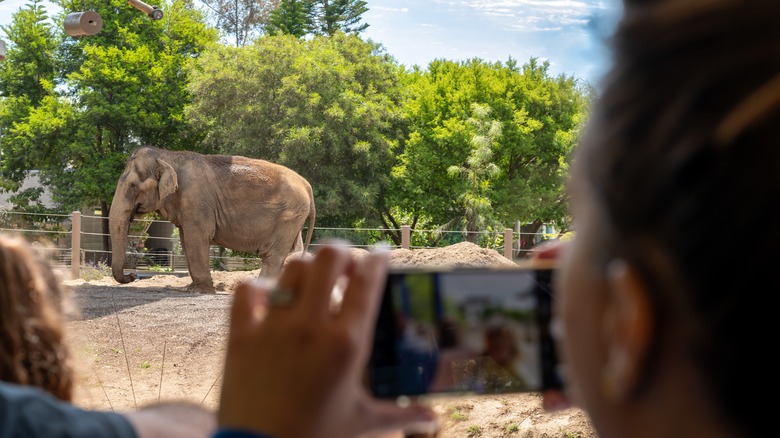The Most Dangerous Animal In A Zoo Isn't A Lion
For most of us, the zoo is the only time we're ever able to see dangerous creatures close-up. Unless we venture out on a safari, we're not going to be hanging out with lions, and unless we happen to live in Florida, which is full of dangerous species, we're probably not going to be encountering any alligators while walking the dog.
At the zoo, however, we're able to get a first-hand look at some of the world's deadliest animals, which is both incredible and sort of terrifying when you think about it. As much fun as it is to get up close and personal with lethal creatures from around the world, we've all seen those videos online of people falling into enclosures and have surely wondered what we'd do in that situation.
While such a thing is very unlikely to happen, we've also surely thought about which animal we'd least like to be trapped with. As it turns out, we shouldn't be as worried about the lions or tigers as we should be about one unlikely animal who is statistically the most dangerous to keep in captivity. Even more unsettling is the fact that this deadly species is frequently allowed to interact with humans.
The zoo animal that poses the biggest threat to humans
Patrons falling into animal enclosures aren't the only terrifying ordeals to unfold at zoos. Every year, there are reports of zookeepers being injured or even killed by the animals to which they tend. In 2024, a Nigerian zookeeper who was mauled to death by lions at a wildlife park after leaving off the safety locks on the animal's enclosure during feeding time. Similarly, back in 2016, a Florida zookeeper was killed by a 13-year-old Malayan tiger after entering an enclosure that the animal also had access to.
But it turns out lions and tigers are not the zoo animals most responsible for human deaths, and they aren't even really the most dangerous creatures in the zoo. According to national animal advocacy nonprofit Born Free USA, elephants are the most dangerous animals to keep in captivity, with captive elephants responsible for more zookeeper deaths than any other animal.
The organization has statistics to back up that claim, too, asserting that between 1990 and 2017, there have been 168 documented incidents in North America that directly involved elephants. Sometimes, they escaped, and other times, they hurt or killed humans or other animals. Even more startling is the fact that more than half of these incidents happened at zoos, with Born Free noting how several zoos still allow customers to interact with elephants directly, whether by posing alongside them for photos, feeding them, or even sitting on the animals' backs — a worrying thought considering captive elephants have managed to injure 53 people and kill 17 between 1990 and 2017.
The tragic record of elephant incidents
Generally speaking, elephants aren't just big; they're also considered the strongest land mammal on the planet, and depending on the specific situation, they can pose a major threat to humans. Factors that play into that threat are sex, circumstance, and environment, but the fact remains that the animals are generally considered to be very dangerous for humans.
While zookeepers are trained to handle dangerous animals, in the case of elephants, there are several examples of the animals injuring or killing experienced handlers even when those handlers followed all the rules. A 2013 incident at Missouri's Dickerson Park Zoo saw a senior keeper killed by a 6,000-pound Asian elephant. The keeper in that example had more than 30 years' experience working with animals, but, despite following all safety precautions on the day in question, was crushed to death in seconds after the elephant trampled him in a narrow corridor. That's far from the only example, too. In 2021, an elephant in Spain killed a zoo keeper with a single strike of its trunk. The 4.4-ton female African elephant struck zoo worker Joaquin Gutierrez Arnaiz and sent him flying into the bars of the enclosure.
This isn't isolated elephant behavior, either. Examples from New Zealand, London, and dozens more stretching back decades also demonstrate how lethal elephants can be. In 1989, people debated how best to keep elephants in captivity following the death of a Tampa animal handler who was crushed by a 3-ton male elephant. Zoo officials at the time publicly acknowledged just how dangerous captive elephants were and that they were responsible for the greatest number of keeper deaths. What's more, according to PETA, since 1978, dangerous incidents involving captive elephants in North America have resulted in 22 human deaths and more than 140 injuries to humans. Despite that, organizations like Call to Conserve note that media coverage — along with efforts by the tourism industry — have essentially painted an inaccurate picture of the animals as "gentle giants."
Elephant captivity is a controversial topic
Elephants' natural habitats vary depending on the species, but small enclosures are one of the things that seem to contribute to elephant aggression. Indeed, there's plenty of evidence to back up these claims. A 2024 study published on PeerJ looked at the state of elephant confinement by examining facilities and considering the improvements being made, as well as the challenges that remain as a result of keeping elephants in captivity. The study, entitled "Continuing challenges of elephant captivity: the captive environment, health issues, and welfare implications," highlighted how many of the challenges that arise from keeping elephants in captivity are the result of a juxtaposition between the captive environment and the "complex, multifaceted characteristics of the elephant's natural environment." The authors urge that while improvements have been made to captive environments, "serious welfare challenges remain."
Meanwhile, other research has shown that elephants live longer in sanctuaries over zoos, and a 2008 study suggested elephants live much longer in the wild than in captivity. All of which shows that these elephant attacks are not only avoidable, but that it's better for the animals themselves to be in their natural environments.
However, that view isn't shared by all. As EuroNews reported in 2023, both the British and Irish Association of Zoos and Aquariums (BIAZA) and the European Association of Zoos and Aquaria (EAZA) criticized calls for U.K. governments to release the country's captive elephants into the wild and commit to an "Elephant-free UK." Head of species management and conservation at BIAZA, Nicky Needham, told the outlet: "The simple fact is that modern zoos and safari parks are compassionate havens for elephants. Don't just believe it because we say so, the evidence is abundant". Tomasz Rusek, EAZA's Director of Advocacy and Communication also argued in favor of elephant captivity, claiming zoos were vital in the fight to conserve elephant numbers around the world. While there is an obvious need to fight against the issues plaguing wild elephant populations, such as poaching and habitat loss, there is clear evidence that captivity is far from the ideal solution which should be taken into account.



